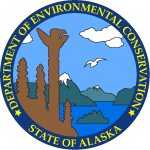| Action Date |
Action |
Description |
DEC Staff |
| 3/1/1993 |
Update or Other Action |
An agreement was established between Elmendorf AFB and the ADEC to complete construction of the new Hush House partially above the area with remaining soil contamination, pending installation of a downgradient well. In March of 1993, four borings were installed during a geotechnical investigation of the new Hush House site. Field screening results did not indicate petroleum hydrocarbon contamination in soil samples collected from these four borings.The area is covered with asphalt and downgradient groundwater analytical results show that contamination is not migrating from the site. |
John Halverson |
| 3/26/1993 |
Update or Other Action |
DOD and ADEC joint Technical Memorandum of understanding signed concerning the Basewide Groundwater (GW) signed by: ADEC Jennifer Roberts RPM and USAF Joseph Williamson Chief Environmental Programs & Restoration. Due to the basewide GW study and the FY92 field work that occurred at Operable Units (OUs) 1, 2, and 5 it appears a large portion of the GW flows into OU5 (attach. 1-contour map). Based on this fact, Elmendorf (EAFB) will move all upgradient GW into the OU5 Feasibility Study, Proposed Plan and Record of Decision (ROD). This means addressing all GW from upgradient sources (CERCLA (ST20, OUs 3 and 4) and OUs 1 and portions of OU2) and SERA) at OU5 instead of at each individual source area (see Attachment 2 - Area Map). Sites with free phased product would be looked at to see if there is an available technology to clean them up in a cost effective way. Soil contamination would be addressed at the source areas. NOTE: addressed at the source areas is interpreted by ADEC as removal through excavation or active treatment systems (e.g. high vacuum extraction, bioventing, etc.). Also included in the file is the AF memo: Restricted Use of the Shallow Aquifer on EAFB signed by William R. Hanson P.E. GM-14 Chief Environmental Flight dated October 17, 1996 Memorandum for 3 SPTG/CEC/CEO from 3 SPTG/CEV. 1) Due to the contamination and commitments to EPA/DEC the use of the shallow aquifer for any purpose on is not allowed. Attached Facilities Board minutes-03/29/1994 0930 Item 9 has Mr. William Hanson, briefing the Board on the policy to not use the shallow aquifer due to contamination. The Board approved this policy. Minutes approved by Thomas R. Case Brigadier General USAF Commander. The IRP has RODs for OUs 3 and 6 which require, the aquifer remain unused. 2) Personnel in the review process within CES must be aware of these policies and review them on a recurring basis. It is imperative this restriction be recognized and observed during engineer reviews and operations. |
Jennifer Roberts |
| 6/17/1994 |
Leaking Underground Storage Tank Release Confirmed - Petroleum |
LUST Site created in CSP for source area ID 75969 (Added by System) |
Jennifer Roberts |
| 6/17/1994 |
Site Added to Database |
|
Former Staff |
| 4/21/1995 |
Update or Other Action |
AF memo: 18 April 1995 UST Meeting. Elmendorf AFB will accomplish the following actions regarding UST Projects. These actions are based upon conversation between, John Mahaffey, Larry Opperman and yourself. EAFB will make every effort to accomplish a clean closure of a UST removal site if possible.
UST removal locations requiring cleanup action will be transferred into the State-Elmendorf Environmental Restoration Agreement (SERA). A list of sites requiring cleanup will be coordinated with your office. The presumptive remedy for contaminated UST sites in the outwash plain only will be bioventing technology. Contaminated soils exceeding cleanup levels may be placed back into the excavation only if the site assessment (SA) indicates a need for further cleanup action.
Contaminated UST sites not in the outwash plain will require further investigation to determine appropriate cleanup options. We will make every attempt possible to assure new USTs or new aboveground tanks are not installed in any way that would hamper future access for cleanup. The project will first accomplish removal of all of the USTs. SA information will be used to proritize sites for cleanup using existing project funds. Additional funding will be requested to complete cleanup if available. Sites not addressed for cleanup due to exhausted funding will be placed into SERA Phase IV. John Halverson signed on April 21, 1995. Memo was signed by Douglas G. Tarbett, Maj, USAF, Chief, Environmental Compliance. CC: 3 WG/JA and 3 SPTG/CE. |
John Halverson |
| 12/8/1995 |
Update or Other Action |
Section 2.2.7 Page 2-11: The draft states groundwater monitoring has been conducted and a no-further-action proposal shall be proposed if the analytical results support such a decision. This issue needs to be addressed prior to submitting a draft final plan. |
Louis Howard |
| 10/17/1996 |
Institutional Control Record Established |
Air Force memo: Restricted Use of the Shallow Aquifer on EAFB signed by William R. Hanson P.E. GM-14 Chief Environmental Flight dated October 17, 1996 Memorandum for 3 SPTG/CEC/CEO from 3 SPTG/CEV
1) Due to the contamination & commitments to EPA/DEC the use of the shallow aquifer for any purpose on is not allowed. Attached Facilities Board minutes-03/29/1994 0930 Item 9 has Mr. William Hanson, briefing the Board on the policy to not use the shallow aquifer due to contamination. The Board approved this policy. Minutes approved by Thomas R. Case Brigadier General USAF Commander. The IRP has RODs for OUs 3 & 6 which require, the aquifer remain unused. 2) Personnel in the review process within CES must be aware of these policies & review them on a recurring basis. It is imperative this restriction be recognized & observed during engineer reviews & operations. |
Louis Howard |
| 3/31/1997 |
Underground Storage Tank Site Characterization or Assessment |
Petroleum contaminated soil was identified beneath the USTs and the dispensers; therefore, additional soil was removed to a maximum depth of 15 to 20 feet below ground surface (bgs) until contamination remained at only two isolated locations. One location was at the bottom of the excavation, approximately 4 feet north of the former MOGAS UST (AFID 290A), sample 11-290-T-2. The diesel-range organics (DRO) concentration at this location was 238 milligrams per kilogram (mg/kg). The other location was at the bottom of the excavation, beneath the former dispenser island, sample 11-290-D-8. The contaminant concentrations at this location were 1,750 mg/kg DRO, 11,000 mg/kg gasoline-range organics (GRO), 280 mg/kg toluene, 68 mg/kg ethylbenzene, and 820 mg/kg total xylenes. Benzene was not detected with a method reporting limit of 0.05 mg/kg.
Recommendations: The ADEC cleanup matrix score classifies this site as a level B cleanup activity. Based upon the amount of material excavated in the tank pit, field screening, and laboratory analytical results, no further action is recommended. However, in the area of the dispenser island pit, it is recommended that a soil boring be placed as close to the original location of the former dispenser as possible, and down gradient to determine whether groundwater contamination has occurred. If hydrocarbon contamination is observed at groundwater elevations, a monitoring well should be installed. The well should be monitored periodically to ensure that identified contamination does not move down gradient. |
Louis Howard |
| 9/15/1997 |
Leaking Underground Storage Tank Cleanup Initiated - Petroleum |
The dispenser island was excavated on 21 April 1994, and sampled for EPH-D, TPH-G, and
BTEX. The samples were taken at the bottom of the pit at an approximate depth of three feet
below grade. The sample results were as follows: EPH-D; 14,000 mg/Kg, TPH-G; 1,300 mg/Kg,
and BTEX ranged from 1.33 mg/Kg Benzene to 68.21 mg/Kg Xylenes. These results indicated
further excavation was needed. Over-excavation of the soils proximal to the dispenser island
began on 27 April 1994. The PID was used to screen soil as it was excavated. During overexcavation activity, 46 PID readings were taken in the dispenser island pit and associated pit soil.
The locations and results from these field surveys are shown on figure 3. Excavation was
continued along each wall of the pit until PID readings were below 100 ppm. Samples were taken
along the bottom of each sidewall, and at two locations on the pit bottom, where PID readings
were the highest. The samples were sent to the analytical laboratory to determine whether further excavation was necessary. Soil samples were analyzed for EPH-D, TPH-G, BTEX, and Lead.
Sample results for EPH-D, ranged from not detected (ND) on the west wall to 79 mg/Kg on the
bottom in the southwest comer. TPH-G was the only constituent detected above the MRL on the
bottom of the dispenser pit.
Toluene and Xylenes were detected below one mg/Kg on the two bottom samples and on the south wall. Additional dispenser pit bottom samples were taken on 9 May 1994 at remaining high PID locations. The results for these samples ranged from 78 mg/Kg EPH-D, and ND TPH-D in the northeast end of the dispenser pit to 1750 mg/Kg EPH-D, and 11 ,000 mg/Kg TPH-D directly beneath the former dispenser island piping. The highest hydrocarbon concentrations were in a column directly beneath the former dispenser island. A duplicate analysis was performed of soils collected from a duplicate sample jar collected a and designated as chain of custody I.D. number 11-290-D-8 .
The piping trench was over-excavated until PID readings were under 100 ppm. A laboratory
sample was collected in the pipe trench bottom approximately three feet below grade. Field
screening samples ranged from 5.9 ppm to 280 ppm in the piping trench (Appendix B, Figure 3).
A lab sample was collected midway between the tank pit, and the dispenser pit. No TPH Gas or
BTEX was detected above the MRL, but 12 mg/Kg EPH-D was detected (Appendix B, Figure 4).
Analytical results are shown in, Appendix C, Table 3.
Eleven field screening samples were taken from soil stockpile one on 21 April 1994. Samples
collected from the west end of soil stockpile one ranged from 45 ppm to 235 ppm. Sample
locations and analytical results from stockpiled soils are shown in Figure 5. Samples taken from
the east end of soil stockpile one ranged from 1894 ppm to over 2500 ppm. Laboratory analytical
samples were collected from all soil stockpiles on 9 May, 1994. Results ranged from 40 mg/Kg
EPH-D in soil stockpile three to 2700 mg/Kg EPH-D in soil stockpile two, and ND TPH-G in soil
stockpile one to 809 mg/Kg TPH-G in soil stockpile two. Approximately 180 cubic yards of soil
was excavated and removed.
The results for sample 11-290-T-2 exceeds ADEC cleanup matrix standards by 38 mg/Kg. Hydrocarbon results from soils in the piping trench are ·below ADEC level B soil matrix cleanup standards. Laboratory analysis of soil samples in the former dispenser island pit show that the cleanup matrix was met for all parameters, except for a small area directly beneath the former dispensers. At this location, the levels of hydrocarbon contamination are in excess of ADEC cleanup standards. Although groundwater was not encountered during this excavation, the potential for groundwater contamination exists. The lowest contaminated sample was taken at approximately 20 feet below grade. Groundwater elevation is approximately 30 feet below grade at this site. |
Louis Howard |
| 8/21/2002 |
Update or Other Action |
RECKEY has automatically been generated. |
Louis Howard |
| 10/21/2002 |
Update or Other Action |
J. Roberts sent a letter to Joe Williamson dissolving the State Elmendorf Environmental Restoration Agreement. The Alaska Department of Environmental Conservation (DEC) has reviewed the issue of abolishing the State Elmendorf Environmental Restoration Agreement (SERA) per your recommendation. Elmendorf Air Force Base and DEC entered into the SERA in 1992. The agreement was developed as a tool to bring the Base into compliance with Alaska's regulations addressing underground storage tanks, oil and other hazardous substance releases and solid waste. Since that time, Elmendorf has made significant progress in investigating and cleaning up historic contamination problems. Many of the sites covered by the SERA have been successfully cleaned up and closed. Cleanup is underway at the remaining sites. Additionally, Alaska has amended the regulations addressing fuel storage tanks, oil and other hazardous substance spills and solid waste. We concur with you that the SERA is no longer a necessary or beneficial. This letter serves as notice that DEC will end oversight on environmental work at Elmendorf by using the SERA. Instead, it is understood that the sites and programs formerly addressed by SERA: solid waste, underground storage tanks (UST), and oil and other hazardous substance discharges will be addressed in accordance with 18 AAC 60, 18 AAC 78 and 18 AAC 75. |
Jennifer Roberts |
| 6/23/2004 |
Conditional Closure Approved |
After reviewing the data and reports submitted for ST408, the Department agrees that no additional remediation or investigation is required for ST408 LUST Event ID 2290.
The Department reserves its rights, under: 18 AAC 75 Contaminated Site regulations, 18 AAC 78 Underground Storage Tank regulations, and AS 46.03 to require additional investigation, cleanup, containment, and/or other necessary actions, if subsequent information indicates: additional contamination remains at the site which was previously undiscovered and presents an unacceptable risk to human health, safety, or welfare, or the environment. |
Jennifer Roberts |
| 6/17/2013 |
Exposure Tracking Model Ranking |
Initial ranking with ETM completed for source area id: 75969 name: ST408 AFID 290A, 290B Bldg 9569 |
Louis Howard |
| 4/4/2016 |
Institutional Control Update |
Land Use Control Inspection Report At State-Regulated Sites With ‘Cleanup Complete - Institutional Control’ Status Joint Base Elmendorf-Richardson, Alaska received.
Site SO513 (ST408) was inspected on 22 October 2015. No deficiencies were noted. |
Louis Howard |
| 9/16/2016 |
Update or Other Action |
Supplemental WP received to address the groundwater sampling, institutional controls (IC) inspection, and landfill cap inspection activities associated with the 2016 Long Term Monitoring (LTM) at the Joint Base Elmendorf-Richardson (JBER), Sites PL081, CG551, ST408, CG530, SO510, SS522, SO507, SS418, TS003, CG543, CG529, TU107, ST048, CG509, SO508, SO549, AT035, AT029, SS019, and DP009.
As a requirement of the 2016 Environmental Long Term Monitoring contract, the following work shall be performed at JBER Site ST408:
? Perform IC inspection |
Louis Howard |
| 5/18/2024 |
Document, Report, or Work plan Review - other |
DEC submitted comments regarding the 2023 Annual Remedial Action-operations And Long-term Management Report for Select State-regulated Sites Draft, Dated April 2024. The report describes the site inspections, maintenance activities, and groundwater monitoring, at multiple sites located on Joint Base Elmendorf- Richardson (JBER), Anchorage, Alaska. Site inspections were recommended to continue for all sites to ensure that conditions remain protective of human health and the environment. The report recommends updating land use controls (LUC) site boundaries at CG534, a ‘Cleanup Complete’ determination without institutional controls (ICs) for SS522, the removal of groundwater LUCs at SS041, and a ‘Cleanup Complete with ICs determination for TU101. |
Ginna Quesada |
| 6/25/2024 |
Document, Report, or Work plan Review - other |
DEC approved the 2023 Annual Remedial Action-operations And Long-term Management Report for Select State-regulated Sites Final, dated June 2024. The report describes the site inspections, maintenance activities, and groundwater monitoring, at multiple sites located on Joint Base Elmendorf- Richardson (JBER), Anchorage, Alaska. Site inspections were recommended to continue for all sites to ensure that conditions remain protective of human health and the environment. The report recommends updating land use controls (LUC) boundaries at CG534, a ‘Cleanup Complete’ determination without institutional controls (ICs) for SS522, the removal of groundwater LUCs at SS041, and a Cleanup Complete with ICs determination for TU101. |
Ginna Quesada |
| 4/15/2025 |
Document, Report, or Work plan Review - other |
DEC provided comments for the 2024 Annual Remedial Action-Operations and Long-Term Management Report for Select State-Regulated Sites Draft, dated April 2025.The report describes the site inspections, maintenance activities, and groundwater monitoring, at multiple sites located on Joint Base Elmendorf- Richardson (JBER), Anchorage, Alaska. Site inspections were recommended to continue for the majority of the sites to ensure that conditions remain protective of human health and the environment. DEC concurs with the recommendation to close SS522 site without ICs, discontinue groundwater sampling at TU107, and reducing the sampling frequency for some wells at TU103. |
Ginna Quesada |
| 5/6/2025 |
Long Term Monitoring Workplan or Report Review |
DEC approved the 2024 Annual Remedial Action-Operations and Long-Term Management Report for Select State-Regulated Sites Final, dated May 2025. The report describes the site inspections, maintenance activities, and groundwater monitoring, at multiple sites located on Joint Base Elmendorf- Richardson (JBER), Anchorage, Alaska. Site inspections were recommended to continue for the majority of the sites to ensure that conditions remain protective of human health and the environment. DEC concurs with the recommendation to close SS522 site without ICs, discontinue groundwater sampling at TU107, and reducing the sampling frequency for some wells at TU103. |
Ginna Quesada |




